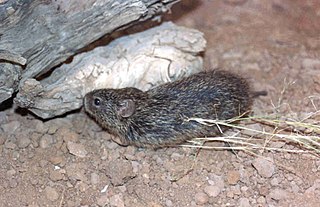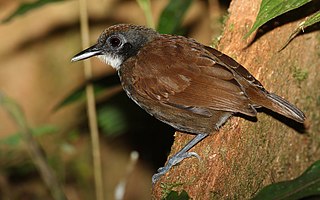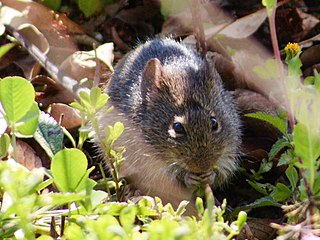
The rodent subfamily Sigmodontinae includes New World rats and mice, with at least 376 species. Many authorities include the Neotominae and Tylomyinae as part of a larger definition of Sigmodontinae. When those genera are included, the species count numbers at least 508. Their distribution includes much of the New World, but the genera are predominantly South American, such as brucies. They invaded South America from Central America as part of the Great American Interchange near the end of the Miocene, about 5 million years ago. Sigmodontines proceeded to diversify explosively in the formerly isolated continent. They inhabit many of the same ecological niches that the Murinae occupy in the Old World.

The blue-tailed emerald is a hummingbird in the "emeralds", tribe Trochilini of subfamily Trochilinae. It is found in tropical and subtropical South America east of the Andes from Colombia east to the Guianas and Trinidad, and south to northern Bolivia and central Brazil.

A cotton rat is any member of the rodent genus Sigmodon. Their name derives from their damaging effects on cotton as well as other plantation crops, such as sugarcane, corn, peanut and rice. Cotton rats have small ears and dark coats, and are found in North and South America. Members of this genus are distributed in the Southwestern United States, Mexico, Central America, and South American countries of: Venezuela, Ecuador, Colombia, Peru, Brazil, Guyana, and Suriname. Many of the species are found in Mexico.
Allen's cotton rat is a species of rodent in the family Cricetidae. It is endemic to western Mexico, where its distribution extends from Sinaloa to Oaxaca. The formerly recognized S. planifrons and S. vulcani are now considered conspecific with S. alleni by the IUCN.

The tawny-bellied cotton rat is a species of rodent in the family Cricetidae. It is found in Mexico and in the US states of Arizona and New Mexico.
The unexpected cotton rat is a species of rodent in the family Cricetidae. It is found only in Ecuador at elevations of 3500 to 4000 m, where it has been found in association with streams and marshes. It is also known as the Ecuadorian cotton rat.
The white-eared cotton rat is a species of rodent in the family Cricetidae. It is found only in Mexico.

The Jaliscan cotton rat or Mexican cotton rat is a species of rodent in the family Cricetidae. It is found only in Mexico. They commonly have brown fur with white fur on the belly. They are ground-dwelling and prefer open habitats.

The yellow-nosed cotton rat is a species of rodent in the family Cricetidae. It is native to Mexico and to the states of Arizona, New Mexico, and Texas in the United States, where it inhabits mountain grassland, scrub, and pinyon-juniper woodland. It is common over much of its wide range and the IUCN considers it to be of "least concern".
Phrynopus peruanus is a species of frog in the family Strabomantidae. It is endemic to Peru. Its natural habitat is subtropical or tropical moist montane forests.
The Peruvian tuco-tuco is a species of rodent in the family Ctenomyidae. It is endemic to Peru and Bolivia.
The montane bamboo rat or Peruvian bamboo rat, is a species of rodent in the family Echimyidae. It is found in Bolivia and Peru. Its natural habitat is subtropical or tropical moist lowland forests.

The white-cheeked antbird is an insectivorous bird in the antbird family Thamnophilidae. It is found to the east of the Andes in Ecuador, Colombia, northern Peru and western Brazil. Its natural habitat is subtropical or tropical moist lowland forests.
The Toltec cotton rat is a rodent species in the family Cricetidae. It is found in eastern Mexico from the Rio Grande to the Yucatán Peninsula, as well as in Belize and northern Guatemala. It prefers moist grassland habitat. While long thought to be a subspecies of S. hispidus, recent taxonomic revisions, based on mitochondrial DNA sequence data, have split the extensive former species range into three separate species. Carroll et al. (2004) indicate that the southern edge of the S. hispidus distribution is likely near the Rio Grande where it meets the northern distribution of S. toltecus. The range of S. toltecus extends from northern Mexico south into Chiapas where it occurs in sympatry with S. hirsutus . Rats from this species group have been used as laboratory animals.

The southern cotton rat is a rodent species in the family Cricetidae. It is found from southern Chiapas in Mexico through Central America, except for Belize, and as far east as northern Colombia and Venezuela. It lives in tropical rainforest, dry forest and savanna, as well as in cultivated areas. The species is terrestrial and primarily diurnal. It was long thought to be a subspecies of S. hispidus. However, recent taxonomic revisions, based on mitochondrial DNA sequence data, have split the extensive former species range into three separate species. Carroll et al. (2004) indicate that the southern edge of the S. hispidus distribution is likely near the Rio Grande where it meets the northern distribution of S. toltecus. The range of S. toltecus extends from northern Mexico south into Chiapas where it occurs in sympatry with S. hirsutus . Rats from this species group have been used as laboratory animals.
The Miahuatlán cotton rat was formerly considered a rodent species in the family Cricetidae. It is found only on the Pacific slope of the Sierra de Miahuatlán in the Mexican state of Oaxaca, where it lives in deciduous tropical forest. The IUCN currently considers it to be conspecific with Sigmodon alleni.
Hoplopleura hirsuta is a sucking louse that is known from North, Central, and South America. Its main hosts are cotton rats such as Sigmodon hispidus, Sigmodon ochrognathus, Sigmodon peruanus, and Sigmodon arizonae.

Merluccius gayi is a merluccid hake of the genus Merluccius, with two subspecies, the South Pacific hake or Chilean common hake and the Peruvian hake, found in the south-western Pacific Ocean, along the coast of South America, from Peru to the Chilean coasts north to the Chiloé Archipelago. During the Southern Hemisphere summer, it migrates southwards in shallow waters, while in the winter, it lives more to the north, in far deeper waters.
Astroblepus peruanus is a species of catfish of the family Astroblepidae. It can be found on the Ucayali River in Peru.

The Peruvian racket-tail is a species of hummingbird in the "brilliants", tribe Heliantheini in subfamily Lesbiinae. It is found in Ecuador and Peru.









